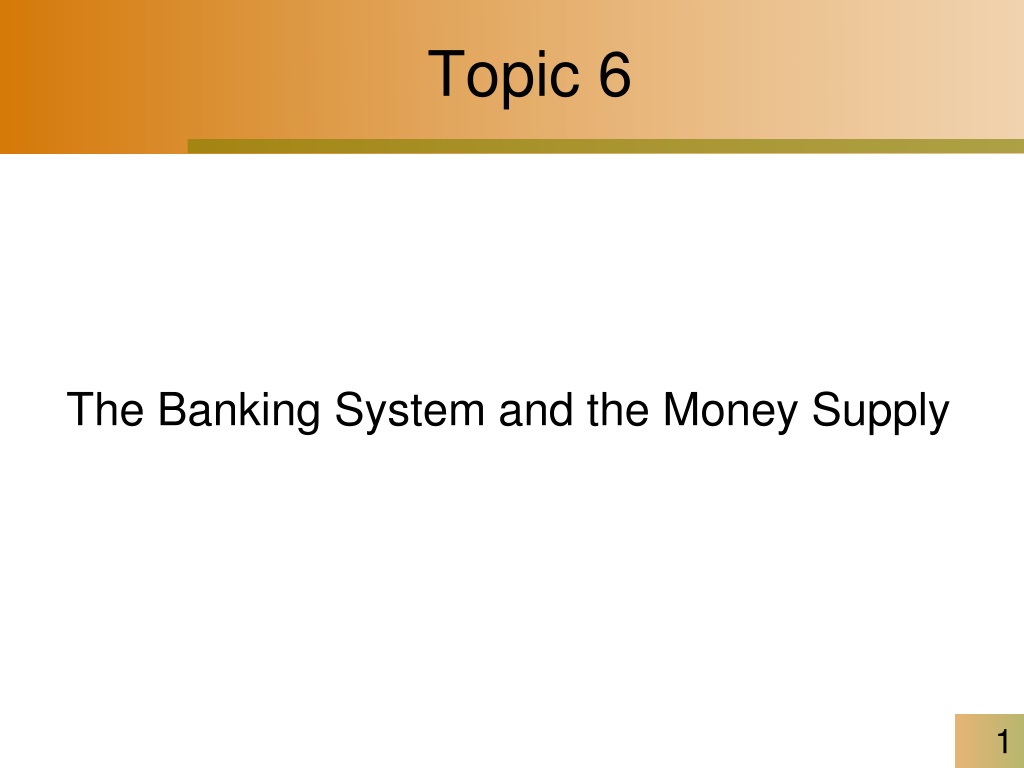Understanding the Banking System and Money Supply
Exploring the concept of money, its functions, what counts as money, measuring the money supply, asset liquidity, and the standard measures M1 and M2 in the context of the banking system and economy.
Download Presentation

Please find below an Image/Link to download the presentation.
The content on the website is provided AS IS for your information and personal use only. It may not be sold, licensed, or shared on other websites without obtaining consent from the author. Download presentation by click this link. If you encounter any issues during the download, it is possible that the publisher has removed the file from their server.
E N D
Presentation Transcript
Topic 6 The Banking System and the Money Supply 1
What Counts as Money Definition of Money Money is an asset that is widely accepted as a means of payment Only assets things of value that people own can be considered as money Can credit cards be considered as money? Only things that are widely acceptable as a means of payment are regarded as money Can stocks or bonds be considered as money? Money has two useful functions Provides a unit of account Standardized way of measuring value of things that are traded Serves as store of value One of several ways in which households can hold their wealth 2
Measuring the Money Supply Money Supply Total amount of money held by the public Governments use different measures of the money supply Each measure includes a selection of assets that are widely acceptable as a means of payment and are relatively liquid An asset is considered liquid if it can be converted to cash quickly and at little cost So, an illiquid asset can be converted to cash only after a delay, or at considerable cost 3
Assets and Their Liquidity Most liquid asset is cash in the hands of the public Next in line are asset categories of about equal liquidity Demand deposits (Checking accounts) Other checkable deposits Travelers checks Then, savings-type accounts less liquid than checking-type accounts, since they do not allow you to write checks Next on the list are deposits in retail money market mutual funds Time deposits (called certificates of deposit, or CDs) Require you to keep your money in the bank for a specified period of time (usually six months or longer) Impose an interest penalty if you withdraw early 4
M1 And M2 Standard measure of money stock (supply) is M1 Sum of the first four assets in our list M1 = cash in the hands of the public + demand deposits + other checking account deposits + travelers checks When economists or government officials speak about money supply, they usually mean M1 Another common measure of money supply, M2, adds some other types of assets to M1 M2 = M1 + savings-type accounts + retail MMMF balances + small denomination time deposits 5
Money Supply We will assume money supply consists of just two components Cash in the hands of the public and demand deposits Our definition of the money supply corresponds closely to liquid assets that our national monetary authority the Federal Reserve can control 7
The Banking System: Financial Intermediaries What are banks? Financial intermediaries business firms that specialize in Collecting loanable funds from households and firms whose revenues exceed their expenditures Channeling those funds to households and firms (and sometimes the government) whose expenditures exceed revenues Intermediaries must earn a profit for providing brokering services By charging a higher interest rate on funds they lend than rate they pay to depositors 8
A Banks Balance Sheet A balance sheet is a financial statement that provides information about financial conditions of a bank at a particular point in time On one side, a bank s assets are listed Everything of value that it owns Property and buildings Bonds Loans Vault cash Account with the Federal Reserve On the other side, the bank s liabilities are listed Amounts it owes Deposits Net worth = Total assets Total liabilities What bank would owe to its owners if it went out of business A balance sheet always balances 9
A Banks Balance Sheet Explanations for vault cash and accounts with Federal Reserve On any given day, some of the bank s customers might want to withdraw more cash than other customers are depositing Banks are required by law to hold reserves Sum of cash in vault and accounts with Federal Reserve Required reserve ratio tells banks the fraction of their checking accounts that they must hold as required reserves Set by Federal Reserve 10
Figure 2: The Geography of the Federal Reserve System 11
Figure 3: The Structure of the Federal Reserve System 12
Federal Reserve Functions Issue currency Set reserve requirements Lend money to banks Collect checks Act as a fiscal agent for U.S. government Supervise banks Control the money supply
Federal Reserve Independence Established by Congress as an independent agency Protects the Fed from political pressures Enables the Fed to take actions to increase interest rates in order to stem inflation as needed
The Federal Open Market Committee Federal Open Market Committee (FOMC) A committee of Federal Reserve officials that establishes U.S. monetary policy Consists of all 7 governors of Fed, along with 5 of the 12 district bank presidents Not even President of United States knows details behind the decisions, or what FOMC actually discussed at its meeting, until summary of meeting is finally released The FOMC exerts control over nation s money supply by buying and selling bonds in public ( open ) bond market 15
The Fed and the Money Supply Suppose Fed wants to change nation s money supply It buys or sells government bonds to bond dealers, banks, or other financial institutions Actions are called open market operations We ll make two special assumptions to keep our analysis of open market operations simple for now Households and business are satisfied holding the amount of cash they are currently holding Any additional funds they might acquire are deposited in their checking accounts Any decrease in their funds comes from their checking accounts Banks never hold reserves in excess of those legally required by law 16
How the Fed Increases the Money Supply To increase money supply, Fed will buy government bonds Called an open market purchase Suppose, by writing a check, Fed buys $1,000 bond from Lehman Brothers, which deposits the total into its checking account Two important things have happened Fed has injected reserve into banking system Money supply has increased Demand deposits have increased by $1,000 and demand deposits are part of money supply (for instance, M1) Lehman Brothers bank now has excess reserves Reserves in excess of required reserves If required reserve ratio is 10% bank has excess reserves of $900 to lend Demand deposits increase each time a bank lends out excess reserves 17
The Demand Deposit Multiplier How much will demand deposits increase in total? Each bank creates less in demand deposits than the bank before In each round, a bank lends 90% of deposit it received So, the total increase in demand deposits is + + = 900 1000 DD So, + = 1000 1000 DD ( + = 0.9 1 1000 1 1000 + 100 2 + 9 . 0 ) 9 . 0 1000 1000 810 9 . 0 + 729 + + + 2 3 0 9 . 0 + 3 0.9 = = 1 9 . 0 Required Reserve Ratio = 1000 10 = 10000 Whatever the injection of reserves, demand deposits will increase by a factor of 10, so we can write DD = 10 x reserve injection 18
The Demand Deposit Multiplier For any value of required reserve ratio (RRR), formula for demand deposit multiplier is 1/RRR Using general formula for demand deposit multiplier, can restate what happens when Fed injects reserves into banking system as follows DD = (1 / RRR) x Reserves With the assumption that the amount of cash in the hands of the public (the other component of the money supply) does not change, we can also write Money Supply = (1 / RRR) x Reserves 19
How the Fed Decreases the Money Supply Just as Fed can decrease money supply by selling government bonds An open market sale Banks have to call in loans in order to meet the required reserve amount with Fed Process of calling in loans will involve many banks Each time a bank calls in a loan, demand deposits are destroyed Total decline in demand deposits will be a multiple of initial withdrawal of reserves Using demand deposit multiplier 1/(RRR), we can calculate the decrease in money supply with the same formula DD = (1/RRR) x reserves This time, the change in reserve is negative 20
Some Important Provisos About the Demand Deposit Multiplier Although process of money creation and destruction as we ve described it illustrates the basic ideas, formula for demand deposit multiplier 1/RRR is oversimplified In reality, multiplier is likely to be smaller than formula suggests, for two reasons We ve assumed that as money supply changes, public does not change its holdings of cash We ve assumed that banks will always lend out all of their excess reserves 21
Other Tools for Controlling the Money Supply There are two other tools Fed can use to increase or decrease money supply Changes in required reserve ratio Changes in discount rate Changes in either required reserve ratio or discount rate could set off the process of deposit creation or deposit destruction in much the same way outlined in this chapter In reality, neither of these policy tools is used very often Why are these other tools used so seldom? Partly because they can have unpredictable effects 22
The Financial Crisis of 2007 and 2008 Mortgage Default Crisis Many causes Government programs that encouraged home ownership Declining real estate values Bad incentives provided by mortgage-backed bonds
The Financial Crisis of 2007 and 2008 Securitization- the process of slicing up and bundling groups of loans into new securities As loans defaulted, the system collapsed Underwater homeowners abandoned homes and mortgages
Velocity of Money (V) Velocity is a measure of the speed money changes hands in transactions for final goods and services Velocity = Nominal GDP Money stock Nominal GDP is the price level (P) times real GDP (Y) M is the money stock. So, V = P x Y M 25
Velocity in the U.S., 2013 M1 = $2,638.8 billion M2 = $10,968.3 billion Nominal GDP = $16,768.1 billion Using M1, velocity is 6.35 $16,768.1 $16,768.1 2,638.8 2,638.8 V = V = = 6.35 Using M2, velocity is 1.53 $16,768.1 10,968.3 V = = 1.53 Velocity is determined by a number of factors including technology such as ATMs and debit cards 26
Money and Inflation in the Long Run The quantity equation states that money times velocity equals nominal GDP, M x V = P x Y Restatement of the velocity definition Shows a relationship between money and price level Suppose velocity and real GDP are constant The quantity equation becomes v and Y , respectively M x V = P x Y An increase in the money supply by a given percentage would increase the price level by the same percentage 27























